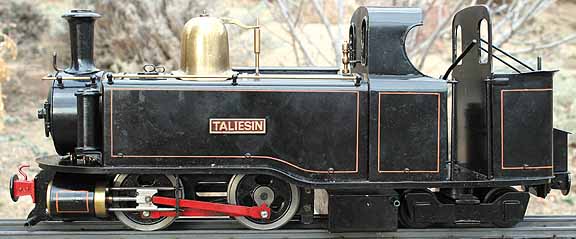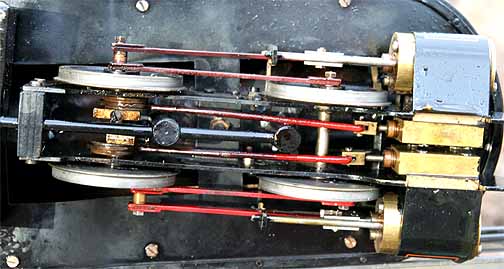
Back to Loco of the Month homepage
Back to Sidestreet Bannerworks
.
March 2006
Archangel 0-4-4T Fairlie
by Marc Horovitz

The prototype
Robert Francis Fairlie is best known for the locomotives that bear his name. These locomotives, while used in various parts of the world, are most closely associated with the 1' 11-1/2"-gauge Ffestiniog Railway in Wales.
Fairlie's locomotives are unusual in that the power truck, or steam bogie, swivels under the boiler, allowing the engine to more easily negotiate rough track and tight curves. Fairlie locomotives came in two flavors -- single and double. The double Fairlies have a cab in the middle and boilers (actually the same boiler with two smoke boxes) at each end. There are two swiveling steam bogies as well.
Taliesin is of the single variety, taking a more conventional locomotive form. This engine was originally built in 1876 by the Vulcan Foundry. It worked on the Ffestiniog until the 1930s, when a new boiler was required. Money could not be raised for this, so the engine was taken to pieces.
Taliesin was resurrected in 1999, essentialy as a new locomotive, but retaining a few parts of the original (like the reversing lever). Some would consider this just a heavy rebuild of the original engine. The new Taliesin is in service today.
The model
Over the years, Archangel has produced an astonishing variety of models. This is part of the attraction of the company's products. They didn't just put a different body on the same cylinders and gear. These different engines really are different from one another.
Archangel has a reputation for taking liberties with its models, as concerns correct proportion, detail, color, and other things. However, the model of Taliesin (without actually scaling it) appears close to the prototype. The model certainly captures the flavor of the full-size locomotive.
A pot boiler is featured, fired by a three-wick alcohol burner. The fuel tank is under the cab and is supported by the frames, so it swivels with the steam bogie. The engine is powered by a pair of D-valve cylinders with inside valves, reversed by slip eccentrics on the second axle. Boiler fittings are rudimentary, and include a throttle, a safety valve under the steam dome, and a couple of plugs on the backhead, which presumably could be used for a pressure gauge and vacuum tap. The engine is nicely finished in gloss-black paint with orange lining. The steam line to the pivoting cylinders is just a length of copper tubing that is allowed to flex as the engine moves.
Although the engine is 10 years old, it has seen little use. I first ran it at Diamondhead some years ago. It ran beautifully -- for a while. Then a slight knocking began, which got louder until the engine sized up. Investigation revealed that a screw that held one of the front wheels to the axles (yes, they are screwed on) had backed out and fouled the side rod. These screws take a very small allen wrench. It's difficult to get a lot of torque to them, especially to the front ones, with the piston rods in the way. This proved to be a recurring problem.
The run
I got Taliesin out of mothballs and took it out to the track for pictures. It immediately fell between the rails. The screws on both sides had worked themselves out and the front wheels were wobbly on the axles. This did not bode well. I got out the wrenches and, after some trouble, succeeded in tightening them up again. I really didn't want to resort to something nasty, like Loctite.
After pictures, I prepared the engine in the usual way. The day was unseasonably warm and a stiff breeze was blowing. I lit the fire and waited. After what seemed like a very long time, the safety finally lifted in its characteristically flatulent way and I opened the throttle.
Taliesin moved smoothly off. One advantage to pot boilers is that the whole engine heats up, so there is little condensate in the cylinders. This engine has relatively large drivers and you'd expect it to be a lively runner. Not so. It is sweet and docile, easily controllable running light or with a load. I hooked up a train of a friend's LGB rolling stock (yes, sacrilege, I know) and Taliesin walked away with them. The performance was quiet , controlled, and exceptionally smooth. This is why I love Archangel engines.
After half an hour or so, I extinguished the fire and allowed the engine to run off residual steam. It ran for a surprisingly long time, finally coming to rest, blissfully with the wheels still intact.
.

|
|
|
| Builder | Archangel Models (Stewart Browne) |
| Date built | 1996 |
| Gauge | 0 (32mm) |
| Scale | 16mm |
| Boiler | Pot |
| Fittings | Safety valve, throttle, two backhead plugs |
| Fuel | Alcohol |
| Blow-off pressure | 40 psi (estimated) |
| Cylinders | Two, double-acting D-valve |
| Reversing gear | Slip eccentric |
| Lubricator | Displacement |
| Weight | 7 lb. |
| Dimensions | Length over buffers, 14"; width, 4-1/4"; height, 5-3/8" |

The two sides of Taliesin. Although a simple engine, mechanically, the body work is fairly sophisticated and captures well the personality of the prototype.
Note the blackened siderods in the lower picture. This was the leeward side of the engine and the flames were often blown by the wind out of what passes for a firebox. Scorched rods are a common trademark of Archangel pot boilers.
.





Left: The spartan cab reveals only a throttle lever. Reversing is accomplished via slip eccentrics.
Above: The paint is gone above the filler tube, a negative effect of the consumption of alcohol. It's not unusual for the filler tubes to ignite during a run, especially on a hot day.
Right: The dummy steam dome slides off to reveal Archangel's usual tall safety valve.
.

.


.
Back to Loco of the Month home page
Back to Sidestreet Bannerworks home page
This page and its contents
Copyright Sidestreet Bannerworks, 2006
.